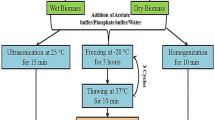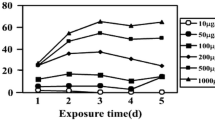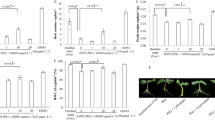Abstract
This investigation was carried out with the aim of determining the effect of paclobutrazol (PBZ) (0 and 2 mg l−1) and polyethylene glycol (PEG) (0, 2, 4 and 6 % w/v of PEG 6000) treatments on antioxidant system of Stevia rebaudiana Bertoni under in vitro condition. Analysis of data showed that PEG treatment significantly increased hydrogen peroxide (H2O2) and phenolic contents, while PBZ treatment limited the effect of PEG on them. Our data revealed that PEG treatment significantly increased total antioxidant capacity, catalase (CAT), ascorbate peroxidase (APX), polyphenol oxidase (PPO) and peroxidase (POD) activity, while it inversely decreased glutathione reductase (GR) activity. The superoxide dismutase (SOD) activity was not affected by PEG treatment. PBZ treatment induced significantly higher levels of CAT and GR activity and lower levels of SOD activity in PEG-treated plants. PBZ in combination with PEG resulted in no significant difference on APX activity with PEG treatment alone. PBZ treatment prevented the effect of PEG on the PPO activity. PEG (with or without PBZ) treatment increased the ascorbate pool, whereas total glutathione level was not affected by PEG. Our finding indicated that PBZ reduced the negative effect of PEG treatment by quenching H2O2 accumulation and increasing the CAT activity. Collectively, the antioxidant capacity of S. rebaudiana in PEG treatment condition was associated with active enzymatic and non-enzymatic defence systems which partly could be improved by the PBZ treatment. In addition, a higher accumulation of phenolic compounds leads to a more potent reactive oxygen species scavenging activity in S. rebaudiana.







Similar content being viewed by others
Abbreviations
- ASC:
-
Ascorbate
- APX:
-
Ascorbate peroxidase
- CAT:
-
Catalase
- DHA:
-
Dehydroascorbate
- EDTA:
-
Ethylenediaminetetraacetic acid
- POD:
-
Peroxidase
- GR:
-
Glutathione reductase
- GSH:
-
Reduced glutathione
- GSSG:
-
Oxidized glutathione
- H2O2 :
-
Hydrogen peroxide
- MDA:
-
Malondialdehyde
- MS:
-
Murashige and Skoog
- NADPH:
-
Nicotinamide adenine dinucleotide phosphate
- NBT:
-
Nitroblue tetrazolium
- PAGE:
-
Polyacrylamide gel electrophoresis
- PBZ:
-
Paclobutrazol
- PEG:
-
Polyethylene glycol
- PPO:
-
Polyphenol oxidase
- ROS:
-
Reactive oxygen species
- SOD:
-
Superoxide dismutase
- TEMED:
-
N,N,N′,N′-tetramethylethylenediamine
References
Aebi, H. (1984). Catalase in vitro. Methods in Enzymology, 105, 121–126.
Asada, K., & Takahashi, M. (1987). Production and scavenging of active oxygen in photosynthesis. In D. J. Kyle, B. Osmond, & C. J. Arntzen (Eds.), Photoinhibition. pp. 227–287. Amsterdam: Elsevier.
Asare-Boamah, N. K., Hofstra, G., Fletcher, R. A., & Dumbroff, E. B. (1986). Triadimefon protect bean plants from water stress through its effect on abscisic acid. Plant and Cell Physiology, 27, 383–390.
Bartosz, G. (1997). Oxidative stress in plants. Acta Physiologiae Plantarum, 19, 47–64.
Basu, S., Roychoudhury, A., Saha, P. P., & Sengupta, D. N. (2010). Differential antioxidative responses of indica rice cultivars to drought stress. Plant Growth Regulation, 60, 51–59.
Beauchamp, C., & Fridovich, I. (1971). Superoxide dismutase: improved assays and an assay applicable to acrylamide gels. Analytical Biochemistry, 44, 276–287.
Bradford, M. (1976). A rapid and sensitive method for the quantification of microgram quantities in utilizing the principle of protein-dye binding. Analytical Biochemistry, 72, 284–254.
Drazkiewicz, M., Skorzynska-Polit, E., & Krupa, Z. (2003). Response of the ascorbate–glutathione cycle to excess copper in Arabidopsis thaliana (L.). Plant Science, 164, 195–202.
Flurkey, W. H., & Jen, J. J. (1980). Purification of peach polyphenoloxidase in the presence of added protease inhibitors. Journal of Food Biochemistry, 4, 29–41.
Foyer, C. H., & Halliwell, B. (1976). The presence of glutathione and glutathione reductase in chloroplasts: a proposed role in ascorbic acid metabolism. Planta, 133, 21–25.
Geuns, M. C. J. (2003). Molecules of interest: stevioside. Phytochemistry, 64, 913–921.
Griffith, O. W. (1985). Glutathione and glutathione disulfide. In H. U. Bergmeyer (Ed.), Methods of enzymatic analysis (pp. 521–529). Weinheim: Verlagsgesellschaft mhH.
Hajihashemi, S., & Ehsanpour, A. A. (2013). Influence of exogenously applied paclobutrazol on some physiological traits and growth of Stevia rebaudiana under in vitro drought stress. Biologia, 68, 1–7.
Hajihashemi, S., Geuns, J.M.C. Radical scavenging activity of steviol glycosides, steviol glucuronide, hydroxytyrosol, metformin, aspirin and leaf extract of Stevia rebaudiana. Free Radicals Antioxidant. In Press, 2014.
Hatano, T., Edamatsu, R., Mori, A., Fujita, Y., & Yasuhara, E. (1989). Effect of interaction of tannins with co-existing substances VI. Effects of tannins and related polyphenols on superoxide anion radical and on DPPH radical. Chemical Pharmaceutical Bulletin, 37, 2016–2021.
Jaleel, C. A., Gopi, R., Alagu Lakshmanan, G. M., & Panneerselvam, R. (2006). Triadimefon induced changes in the antioxidant metabolism and ajmalicine production in Catharanthus roseus (L.) G. Don. Plant Science, 171, 271–276.
Kampfenkel, K., Van Montagu, M., & Inzé, D. (1995). Extraction and determination of ascorbate and dehydroascorbate from plant tissue. Analytical Biochemistry, 225, 165–167.
Kim, I. S., Yang, M., Lee, O. H., & Kang, S. N. (2011). The antioxidant activity and the bioactive compounds content of Stevia rebaudiana water extracts. Food Science and Technology, 44, 1328–1332.
Kocsy, G., Galiba, G., & Brunold, C. (2001). Role of glutathione in adaptation and signaling during chilling and cold acclimation in plants. Plant Physiology, 113, 158–164.
Kraus, T. E., & Fletcher, R. A. (1994). Paclobutrazol protects wheat seedlings from heat and paraquat injury. Is detoxification of active oxygen involved? Plant and Cell Physiology, 35, 45–52.
Lemus-Mondaca, R., Vega-Galvez, A., Zura-Bravo, L., & Ah-Hen, K. (2012). Stevia rebaudiana Bertoni, source of a high-potency natural sweetener: a comprehensive review on the biochemical, nutritional and functional aspects. Food Chemistry, 132, 1121–1132.
Marshall, J. G., Rutledge, R. G., Blumwald, E., & Dumbroff, E. (2000). Reduction in turgid water volume in jack pine, white spruce and black spruce in response to drought and paclobutrazol. Tree Physiology, 20, 701–707.
Marshall, J. G., Scarrat, J. B., & Dumbroff, E. B. (1991). Induction of drought resistance by abscisic acid and paclobutrazol in jack pine. Tree Physiology, 8, 415–421.
McKersie, B. D., Bowley, S. R., & Jones, K. S. (1999). Winter survival of transgenic alfalfa overexpressing superoxide dismutase. Plant Physiology, 119, 839–848.
Michel, B. E., & Kaufmann, M. R. (1973). The osmotic potential of polyethylene glycol 6000. Plant Physiology, 51, 194–196.
Moller, I. M., Jensen, P. E., & Hansson, A. (2007). Oxidative modifications to cellular components in plants. Annual Review of Plant Biology, 58, 459–481.
Murashige, T., & Skoog, F. (1962). A revised medium for rapid growth and bioassays with tobacco tissue cultures. Plant Physiology, 15, 473–479.
Noctor, G., & Foyer, C. (1998). Ascorbate and glutathione: keeping active oxygen under control. Annual Review of Plant Physiology and Plant Molecular Biology, 49, 249–279.
Pastori, G. M., & Trippi, V. S. (1993). Cross resistance between water and oxidative stresses in wheat leaves. Journal of Agricultural Science, 120, 289–294.
Patade, V. Y., Bhargava, S., & Suprasanna, P. (2012). Effects of NaCl and iso-osmotic PEG stress on growth, osmolytes accumulation and antioxidant defense in cultured sugarcane cells. Plant Cell, Tissue and Organ. Culture, 108, 279–286.
Plewa, M. J., Smith, S. R., & Wanger, E. D. (1991). Diethyldithiocarbamate suppresses the plant activation of aromatic amines into mutagens by inhibiting tobacco cell peroxidase. Mutation Research, 247, 57–64.
Sakthivelu, G., Devi, M. K. A., Giridhar, P., Rajasekaran, T., Ravishankar, G. A., Nedev, T., et al. (2008). Drought-induced alterations in growth, osmotic potential and in vitro regeneration of soybean cultivars. General and Applied Plant Physiology, 34(1–2), 103–112.
Sen, A., & Alikamanoglu, S. (2011). Effect of salt stress on growth parameters and antioxidant enzymes of different wheat (Triticum aestivum L.) varieties on in vitro tissue culture. Fresenius Environmental Bulletin, 20, 489–495.
Shehab, G. G., Ahmed, O. K., & El-Beltagi, H. S. (2010). Effects of various chemical agents for alleviation of drought stress in rice plants (Oryza sativa L.). Notulae Botanicae Horti Agrobotanici Cluj, 38(1), 139–148.
Shukla, S., Mehta, A., Mehta, P., & Bajpai, V. K. (2012). Antioxidant ability and total phenolic content of aqueous leaf extract of Stevia rebaudiana Bert. Experimental Toxicologic Pathology, 64(7–8), 807–811.
Singleton, V. L., & Rossi, J. R. (1965). Colorimetry of total phenolics with phosphomolybdic–phosphotungstic acid reagent. American Journal of Enology and Viticulture, 16, 144–158.
Szôllôsi, R. (2002). Varga, I.S. Total antioxidant power in some species of Labiatae (Adaptation of FRAP method). Proceedings of the 7th Hungarian Congress on Plant Physiology. Acta Biologica Szegediensis, 46, 125–127.
Thipyapong, P., Kelkonian, J., Wolfe, D. W., & Steffens, J. C. (2004). Suppression of polyphenol oxidases increases stress tolerance in tomato. Plant Science, 167, 693–703.
Torres-Franklin, M. L., Contour-Ansel, D., Zuily-Fodil, Y., & Pham-Thi, A. T. (2008). Molecular cloning of glutathione reductase cDNAs and analysis of GR gene expression in cowpea and common bean leaves during recovery from moderate drought stress. Journal of Plant Physiology, 165, 514–521.
Ünyayar, S., Keleş, Y., & Çekiç, F. Ö. (2005). The antioxidative response of two tomato species with different drought tolerances as a result of drought and cadmium stress combinations. Plant, Soil and Environment, 51, 57–64.
Velikova, V., Yordanov, I., & Edrava, A. (2000). Oxidative stress and some antioxidant systems in acid rain-treated bean plants. Protective role of exogenous polyamines. Plant Science, 151, 59–66.
Veljovic-Jovanovic, S., Kukavica, B., Stevanovic, B., & Navari-Izzo, F. (2006). Senescence- and drought-related changes in peroxidase and superoxide dismutase isoforms in leaves of Ramonda serbica. Journal of Experimental Botany, 57, 1759–1768.
Xu, X. Y., Shi, G. X., Wang, J., Zhang, L. L., & Kang, Y. N. (2011). Copper-induced oxidative stress in Alternanthera philoxeroides callus. Plant Cell, Tissue and Organ. Culture, 106, 243–251.
Zhang, J., & Kirkham, M. B. (1996). Antioxidant responses to drought in sunflower and sorghum seedlings. New Phytologist, 132, 361–373.
Zhu, L. H., Peppal, A., Li, X. Y., & Welander, M. (2004). Changes of leaf water potential and endogenous cytokinins in young apple trees treated with or without paclobutrazol under drought conditions. Scientia Horticulturae, 99, 133–141.
Živković, S., Popović, M., Dragišić-Maksimović, J., Momčilović, I., & Grubišić, D. (2010). Dehydration-related changes of peroxidase and polyphenol oxidase activity in fronds of the resurrection fern Asplenium ceterach L. Archives of Biological Science Belgrade, 62(4), 1071–1081.
Acknowledgments
The authors wish to thank the University of Isfahan and the Plant Stress Center of Excellence (PSCE) for their support and Stijn Ceunen for the help with the manuscript.
Author information
Authors and Affiliations
Corresponding author
Rights and permissions
About this article
Cite this article
Hajihashemi, S., Ehsanpour, A.A. Antioxidant Response of Stevia rebaudiana B. to Polyethylene Glycol and Paclobutrazol Treatments Under In Vitro Culture. Appl Biochem Biotechnol 172, 4038–4052 (2014). https://doi.org/10.1007/s12010-014-0791-8
Received:
Accepted:
Published:
Issue Date:
DOI: https://doi.org/10.1007/s12010-014-0791-8




